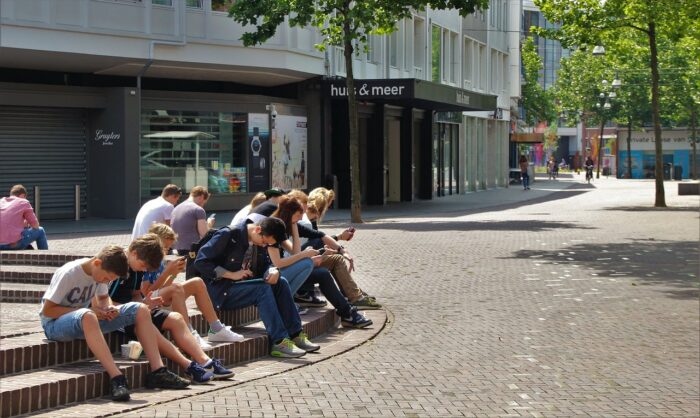Ways How Teens Meet New Friends Today
Nowadays, teenagers are far more likely to meet new people on social media sites or when playing online video games. We can easily refer to it as digitally-initiated friendships. Statistics say that 57% of teens made friends with other kids online, either when using their social media profiles or when joining a game. Is the process safe and beneficial or are there insidious risks involved?

Where do teens find new friends?
Present-day teens get acquainted with one another in multiple ways – to name only the most ordinary of them:
Through profiles on social media
It’s common for teens nowadays to have accounts on social media platforms such as Instagram, Snapchat, and TikTok where they visit other teens’ profiles and strike up relationships. When they get interested in someone they leave comments and engage those guys in conversations online.
Through playing games online
Online games have become platforms where a lot of discussions are going on. Playing Fortnite, Minecraft, and Among Us teens make up teams and work out strategies which leads to building close and permanent relationships.
Through school activities
Multiple activities at school involve children in team games, playing music together, performing plays that help school kids mix. Also, there are various clubs at school.
Through community holidays
People in residential areas often get together for fairs, festivals, and other events where one can meet someone new and join new groups.
Through extracurricular activities

Many things happen at schools outside the curriculum: sports competitions, various performances, activities of community organizations – all these extracurricular activities engage a lot of teenagers who can build relationships in an active and entertaining atmosphere. Extracurricular activities help them to be among peers with the same interests.
As online pastime grows in popularity, teens meet one another online more frequently – yet it involves risks they should be aware of.
What are the risks of meeting new friends online and staying active on social media?
Making friends online is undoubtedly an easy and engaging process, but it is fraught with risks. Online mixers should be conscious of certain dangers of online socializing, such as ones listed below:
Identification disclosure: children can give out their personal details freely not realizing that their names and addresses can make them targets for identity thieves.
Online bullying: there are kids who go in for cyberbullying, and those they target can suffer emotionally from their activities.
Predator activity: some people go online to indulge in meanness. They conceal their identities and, making out they’re someone else, wreak as much harm as they can. Teens can be especially vulnerable to experienced predators.
Fraudulent schemes: unsuspecting teens might be involved in online fraudulent schemes intended to rob them of money and steal their identity.
Deliberate exhibition of unlawful content: since many platforms cannot be moderated with sufficient efficacy, teens might be exposed to content containing violence, pornography, and extremism.
Since everybody can access social media, bad-meaning people can discredit others. Social profiles are designed for self-expression, and it’s great, but, on the other hand, when someone wants to leave comments of a detrimental nature, abuse or put people to ridicule, it would be very difficult to avoid this sort of mistreatment. A sensitive teenager may be exposed to cyberbullying, their reputation may be brought down, and malicious gossip about them disseminated. All this is harmful for teens’ well-being and causes great anxiety.
Decrease self-estimation: other people’s images on social sites can be overblown so as to produce a highly idealized impression – that results in comparing oneself to others unfavorably and building a notion of inadequacy.
How to minimize the risks?

As your teen goes online, he or she ought to be aware of measures they can take to avoid falling into online traps:
- They should know which social sides are more reputable, make use of those communication platforms that are safe and display clear guidelines.
- They must be aware that they are free to use privacy settings allowing them to blacklist those who make them feel bad.
- Teens should realize that other people online don’t need to know their personal details and they shouldn’t give anyone their names, addresses, and phone numbers. This is only for those they know personally and who can be trusted not to misuse this information.
- Make your kid(s) understand they mustn’t agree to meet other people or give them their personal details before they get to know exactly who these persons are. First, they should ascertain their identity by talking to them in video mode or contacting them on the phone.
- It is natural to want to meet somebody with whom you have chatted so much, but still, one has to observe certain safety rules. The meeting place should be chosen somewhere crowded, where there are people to call for help, if it should become necessary; besides, before going out the teen should inform a member of the family about the forthcoming tryst.
- Young ones should be taught to develop their gut feelings and recognize red signals during online socializing. Once they have felt that things are fishy in any way, they would do well to cut off any communication with the suspicious person, then report the incident to the platform moderators or to a family member.

- Discuss with your kid(s) the desirability of being digitally polite and respectable towards others. They would do well to steer clear of cyberbullying and distributing speculations/inappropriate and insulting content.
- Teach your kid(s) to discuss with their parents and/or relatives their online friends and voice their troubles over online communication. Family members or guardians can help children to feel safe and comfortable when going online.
If these simple measures are taken, your teenagers can avoid the risks of meeting inappropriate and ill-meaning persons online and maintain their online communications on a pleasant and danger-free level.
